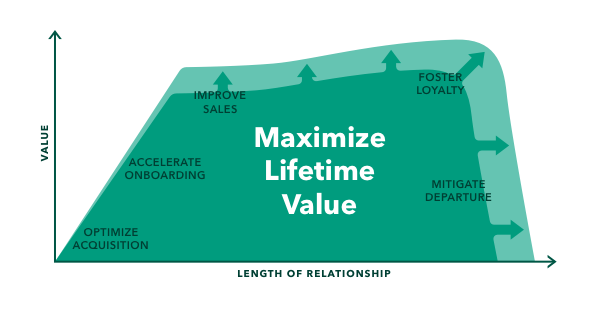Breaking down customer conversations, building up customer experiences
Moving. Paying bills. Flying home.
Each of these journeys opens the door to improving customer experiences and, ultimately, maximizing customer lifetime value. The key to unlocking that door, however, starts with reaching out for feedback from your customers. It’s important to take a holistic approach by analyzing feedback from three different levels of the customer experience: touchpoint-level, journey-level, and relationship-level.
Touchpoint-level feedback: Which moments matter most in customer experiences?
We think of a touchpoint as the intersection of a customer’s need at a point in time and how a business engages with and meets the customer in that instance. This intersection is defined by the channel of the interaction — e.g. a social media exchange, phone call, email, online portal, kiosk, store transaction, etc. — and what the customer is trying to do as they engage within that channel.
 Consider the flying home example — touchpoints may include:
Consider the flying home example — touchpoints may include:
- Purchasing your ticket, likely defined by a digital channel such as the airline’s app or website and the goal of securing a ticket
- Checking in to your flight either ahead of time online or in person at the airport to get your boarding pass
- Speaking to a customer service representative when airline delays cause an extended layover at 12:30 a.m.
These specific interactions are part of a greater customer journey or story — and they each represent an opportunity to gather feedback and learn more about that story. While an unexpected layover makes for a pretty negative journey, the customer service representative may provide a very positive touchpoint experience through how she handles your frustration. But how much does her empathy to your plight really matter to the overall journey if you're still left stranded in the airport?
By getting feedback at the touchpoint level, you can pinpoint exactly which moments impact the customer journey most and which ones you might not need to focus on. However, if you solely measure individual touchpoints, you could easily have a distorted view of the journey. Instead, you have to consider every touchpoint in the context of the journey.
Journey-level feedback: Navigating omnichannel success
A customer journey occurs over one or more touchpoints, starting when the customer identifies a need and ending when that need is fulfilled (or not). Journeys impact overall satisfaction and business outcomes more than touchpoints alone because they focus on the ultimate customer need and ability to satisfy it.
As the number of ways customers can interact with your company increases, a journey-centric approach to gathering and utilizing feedback inevitably makes your customer experience more omnichannel. Journeys often take place across several channels, so it’s critical to align those channels and create a cohesive, seamless experience. The last thing you want is for someone to submit a help request online and have your call center not know about it by the time the customer reaches out to follow up. All of your processes, systems, and employees need to synchronize across channels to deliver a pleasant and successful customer experience.
Relationship-level feedback: How do your customers perceive you?
While touchpoints and journeys focus on specific interactions or experiences, relationship-level feedback focuses on the full customer lifecycle. Once you’ve put in the hard work to acquire a customer, it’s important to keep them. When looking to reduce churn and maximize lifetime value, you should seek to understand how your current customers feel about their relationship with you.
This feedback does not revolve around a particular interaction or engagement. Rather, it's an aggregate assessment of a customer's experiences, derived by asking them about the company's specific attributes or features based on their overall history as a customer. Using this type of feedback, you can analyze customer lifecycles to achieve greater customer conversion, retention, and devotion.
When it comes to the overall relationship, the most effective approach to customer experience is focused on the bottom line — identifying actionable ways to maximize customer lifetime value. Growth can and should happen at every stage of the customer relationship by adding more customers, increasing spend, minimizing churn, and improving loyalty.

Customer Feedback — The Bigger Picture
When looking to influence improvement initiatives, you want to consider these three feedback levels together to gain an all-encompassing and representative understanding of the customer experience. Measuring just one or two levels without the others can lead to a distorted view of the true customer experience. By analyzing touchpoints in the context of journeys and journeys in the context of the relationship, we gain a complete vision of the customer experience across their lifecycle with the business. Get connected with a customer experience specialist to start collecting robust customer feedback across touchpoints, journeys, and relationships.